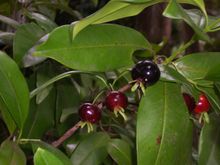Grumichama
Appearance
| Grumichama | |
|---|---|

| |
| Fruits of the grumichama (Eugenia brasiliensis) | |
| Scientific classification | |
| Kingdom: | Plantae |
| Clade: | Tracheophytes |
| Clade: | Angiosperms |
| Clade: | Eudicots |
| Clade: | Rosids |
| Order: | Myrtales |
| Family: | Myrtaceae |
| Genus: | Eugenia |
| Species: | E. brasiliensis
|
| Binomial name | |
| Eugenia brasiliensis | |
| Synonyms[1] | |
| |
Eugenia brasiliensis, with common names Brazil cherry[2] and grumichama,[2] or the Brazilian cherry[3] is medium-sized tree (maximum 20 meters height) endemic (native) to southern Brazil which bears small fruits that are purple to black in color, and have a sweet cherry to plum-like flavor.[4]
It's a small size tree which makes it perfect to use in urban landscaping. Its slow growth and low rate of dispersal make it rare, and it is generally considered as an endangered species.[5]
The inner flesh of the fruit is white yellowish in appearance, it's mostly used for fresh eating but can also be used in making jams, jellies and pies.[3]
Gallery
References
- ^ "The Plant List: A Working List of All Plant Species". Retrieved February 7, 2014.
- ^ a b "Eugenia brasiliensis". Germplasm Resources Information Network. Agricultural Research Service, United States Department of Agriculture. Retrieved 27 December 2014.
- ^ a b "Grumichama Black Tree - Eugenia brasiliensis". www.daleysfruit.com.au. Retrieved 2020-01-10.
- ^ All About Grumichama!, retrieved 2020-01-10
- ^ Paulo Backes & Bruno Irgang, Mata Atlântica: as árvores e a paisagem, Porto Alegre, Paisagem do Sul, 2004, page 316.
External links
Wikispecies has information related to Eugenia brasiliensis.
Wikimedia Commons has media related to Eugenia brasiliensis.




